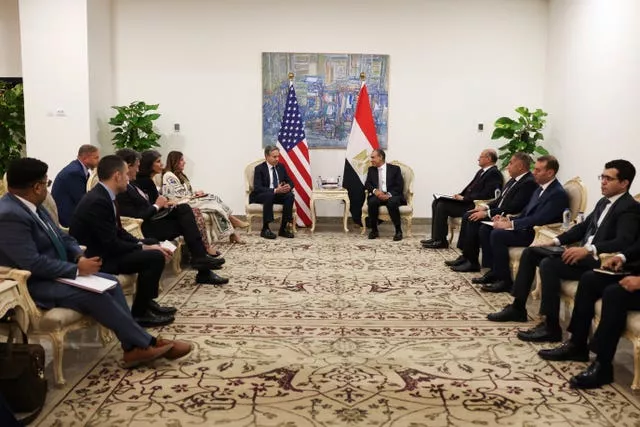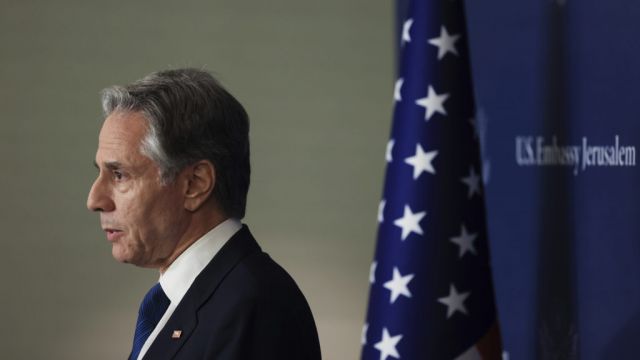Antony Blinken has ended his ninth visit to the Middle East since the war in Gaza began without securing a ceasefire deal.
The US secretary of state warned on Tuesday that “time is of the essence” even as Hamas and Israel signalled that challenges remain.
After meetings in fellow mediating countries Egypt and Qatar, Mr Blinken said that because Israel has accepted a proposal to bridge gaps with the militant group, the focus turns to doing everything possible to “get Hamas on board” and ensure both sides agree to key details on implementation.

“Our message is simple. It’s clear and it’s urgent,” he told reporters before leaving Qatar. “We need to get a ceasefire and hostage agreement over the finish line, and we need to do it now. Time is of the essence.”
There has been added urgency to reach a deal after the recent targeted killings of militant leaders of Hamas and Hezbollah in Iran and Lebanon, both attributed to Israel, and vows of retaliation that have sparked fears of a wider regional war.
Few details have been released about the so-called bridging proposal put forth by the US, Egypt and Qatar. Mr Blinken said it is “very clear on the schedule and the locations of (Israeli military) withdrawals from Gaza”.
Hamas earlier on Tuesday called the latest proposal a reversal of what it had agreed to, accusing the US of acquiescing to new conditions from Israel. There was no immediate US response to that.
Israeli Prime Minister Benjamin Netanyahu, meanwhile, met with right-wing groups of families of fallen soldiers and hostages in Gaza. The groups, which oppose a ceasefire deal, said Mr Netanyahu told them Israel will not abandon two strategic corridors in Gaza whose control has been an obstacle in the talks. Mr Netanyahu’s office did not comment on their account.
A senior US official rejected as “totally untrue” that Mr Netanyahu had told Mr Blinken that Israel would never leave the Philadelphi and Netzarim corridors. Such statements are “not constructive to getting a ceasefire deal across the finish line,” the official said.
Mr Blinken’s meetings in Egypt, which borders Gaza, and in Qatar, which hosts some Hamas leaders in exile, came a day after he met Mr Netanyahu. Wide gaps appeared to remain between Israel and Hamas, though angry statements often serve as pressure tactics during negotiations.
Mr Netanyahu’s meeting with the families came as Israel’s military said it recovered the bodies of six hostages taken in Hamas’s October 7 attack that started the war, bringing fresh grief for many Israelis who have long pressed Mr Netanyahu to agree to a ceasefire that would bring remaining hostages home.
New protests were held on Tuesday. “The longer they’re there, the more body bags we get,” said one protester, Adi Israeli, in Tel Aviv.

Israel’s military said it recovered the six bodies in an overnight operation in southern Gaza, saying they were killed when troops were operating in Khan Younis. Hamas says some captives have been killed in Israeli air strikes, though returning hostages have talked about difficult conditions, including lack of food or medications.
The recovery of the remains also is a blow to Hamas, which hopes to exchange hostages for Palestinian prisoners, an Israeli withdrawal and a lasting ceasefire.
The military said it had identified the remains of Chaim Perry, 80; Yoram Metzger, 80; Avraham Munder, 79; Alexander Dancyg, 76; Nadav Popplewell, 51; and Yagev Buchshtav, 35.
Kibbutz Nir Oz, the farming community where Mr Munder was among around 80 residents seized, said he died after “months of physical and mental torture”. Israeli authorities previously determined the other five were dead.

Hamas is still believed to be holding around 110 hostages captured during the October 7 attacks, when militants killed some 1,200 people, mostly civilians. Israeli authorities estimate around a third are dead. Over 100 other hostages were released during last year’s ceasefire in exchange for Palestinians imprisoned in Israel.
Israel’s retaliatory offensive has killed more than 40,000 Palestinians, according to Gaza’s Health Ministry, which does not distinguish between civilians and combatants in its count. The war has caused widespread destruction and forced the vast majority of Gaza’s 2.3 million residents to flee their homes, often multiple times. Aid groups fear the outbreak of polio and other diseases.
An Israeli air strike on Tuesday killed at least 12 people at a school-turned-shelter in Gaza City. The Palestinian Civil Defence, first responders operating under the Hamas-run government, said around 700 people had been sheltering at the Mustafa Hafez school. Israel’s military said the strike targeted Hamas militants who had set up a command centre there.
“We don’t know where to go … or where to shelter our children,” said Um Khalil Abu Agwa, a displaced woman.
An Israeli air strike in Deir al-Balah hit people walking down the street and seven were killed, including a woman and two children, according to an Associated Press journalist who counted the bodies. Another air strike in central Gaza killed five children and their mother, according to Al-Aqsa Martyrs Hospital, where an AP journalist counted the bodies.
Palestinians displaced by recent Israeli evacuation orders crowded into already teeming areas. One child in Deir al-Balah slept on cardboard as insects flew around his face.
“Are they going to dig the ground and dump us there, or put us on a boat and throw us in the sea? I don’t know,” said one man, Abu Shady Afana.







